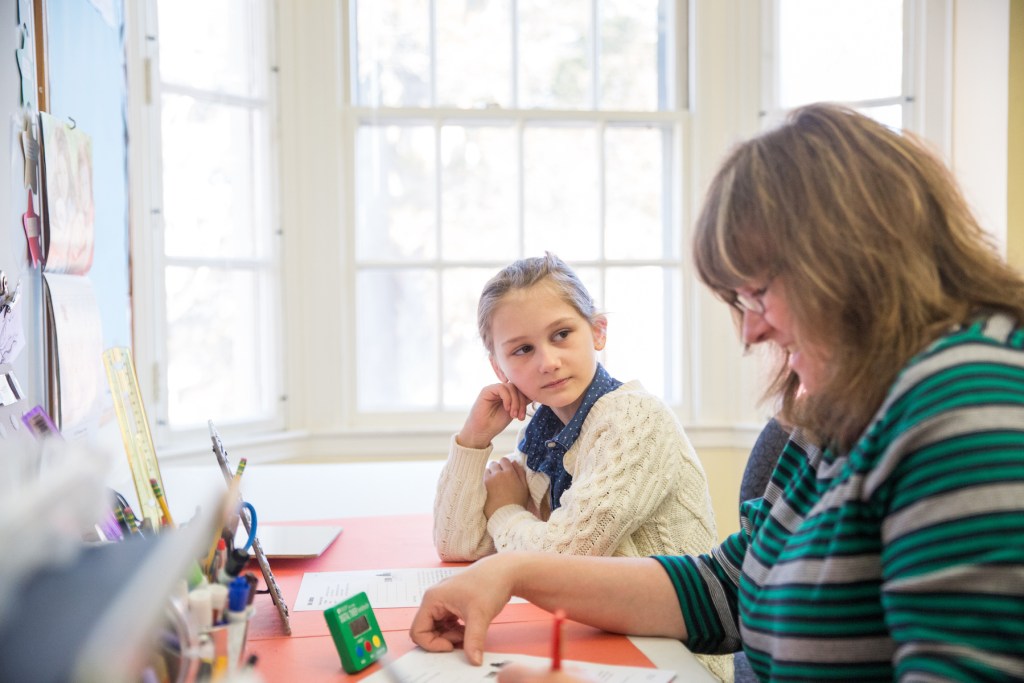- Our School
- Our Advantage
- Admission
- Elementary•Middle School
- High School
- Summer
- Giving
- Parent Resources
- For Educators
- Alumni
« Back
Tips for Parents Who Suspect Their Child Has a Learning Disability
September 13th, 2018

By Ann Andrew
Parents know their children better than anyone else and can usually sense if something isn’t quite right with them physically, emotionally, or academically. If you suspect that your child has a learning disability, then it’s very likely there is one. I know this from experience. As an elementary school student, my oldest son struggled in school, particularly with reading. An intelligent boy, I assumed his difficulties stemmed from some sort of learning disability. He was diagnosed with dyslexia in 2011 (my two other sons were subsequently also diagnosed with dyslexia), and since then I have devoted myself to helping students with language-based learning disabilities (LBLD). LBLDs fall under the broader category of specific learning disabilities (SLD), and dyslexia is the most common SLD, according to the National Center for Learning Disabilities.
"A child who reads for 20 minutes a day is exposed to 1.8 million words a year."
Be Honest With Your Child
Your child knows they’re different. Don't try to hide what you know or suspect from them. A parent who keeps the information from them leaves the child feeling like the parent is ashamed of the child's learning difference. Your child will also benefit from speaking to a professional (neuropsychologist, school psychologist, therapist with a comprehensive understanding of LDs) once—or many times. Children need to have at least a basic understanding of the science behind how we learn to acquire language—read, and write. They need to hear from as many adults as possible that they are not “broken” or “dumb.”
Early Signs of Dyslexia and Other LBLDs
If you struggled to read (or do math or write), it's quite possible that you also have a learning disability that went undiagnosed. Parents with dyslexia have a 40-60 percent chance of having children with dyslexia—a clear early warning sign that your child may have an LBLD. Your hatred of a subject is probably borne from not being taught in a manner that was accessible to your learning style or disability.
Oral (expressive) language deficit: It’s a warning sign if you have a chit-chatting toddler who is making indecipherable sounds and words or seems challenged by learning new words.
Auditory (receptive) language deficit: Ask questions if a doctor has diagnosed your child with ADHD without addressing the possibility of an LBLD or an auditory processing disorder. Children with ADHD have the ability to process language, while children with an LBLD have a weakened ability in this area. Their slower processing of language impedes their capacity to comprehend spoken language. For these children, it is not an “inattention issue.” To complicate matters it's very common to see comorbidity (the presence of more than one distinct condition) of ADHD and dyslexia together.
Executive functioning deficits: Difficulties with attention, organization, and self-regulation are often comorbid with LBLD.
Social skills deficits: Often excused as “developmental delays,” social skills deficits can also be comorbid with learning disabilities. Ask your child’s preschool teacher if they play appropriately in school. Have they progressed from parallel to cooperative play successfully? Are they well liked by their peers or often misunderstood? Observe your child at school and see how other children interact with them in that setting. Children with dyslexia and other LBLDs can present symptoms of depression, anxiety, oppositional behavior, or disengaged behavior, in school and/or at home, which can be effects of being misunderstood or repeatedly asked to do something they do not have the skill yet to accomplish.
Facts vs Myths
Myth: Boys develop slower.
Fact: It’s not scientifically proven that one gender develops faster than the other.
Myth: We should wait and see what happens with our struggling children. “Teacher so-and-so is really good at helping kids who are struggling to read."
Fact: With early, intensive, and evidence-based intervention and instruction, children with dyslexia and other LBLDs can learn to read like their non-dyslexic peers.
Myth:Accommodations or modifications are sufficient for children with LBLDs.
Fact:Dyslexia and other LBLDs can be remediated. The longer you wait to obtain the diagnosis, the harder and more expensive it is to remediate. Accommodations or modifications without a diagnosis will not unlock your child’s potential.
Myth: People with dyslexia will never enjoy reading.
Fact: Many, many individuals with dyslexia love to read and are voracious readers. A child who reads for 20 minutes a day is exposed to 1.8 million words a year. These words help to foster a love of learning, the belief that you can dream big and achieve those goals, and confidence to make a smooth transition to college, employment, and independent living.
Parent To Do List
No two children share the same learning profile, so there’s no one-size-fits-all path to diagnosis and services. Based on my experience, here are my suggestions on how to navigate the special education landscape.
Initial diagnostic evaluations Obtain a full audiological and full vision evaluation (not a screening by the pediatrician or the school) prior to or in conjunction with any evaluation for LBLDs. Note that some advocates suggest that the child has the vision evaluation before any other testing. In addition, neuropsychologists can test for auditory processing issues and recommend a full audiological evaluation if they feel one is necessary.
If you are going to have your school district evaluate the child, be sure to put in writing that you are requesting the audiological evaluation for hearing and auditory processing be conducted by an audiologist, a vision and visual processing evaluation by an ophthalmologist, and a full neuropsychological evaluation by a neuropsychologist. This will give you a stronger opportunity to exercise your right to these types of professionals as independent evaluators if you feel the district fails to provide a comprehensive, accurate, and complete report for all areas of suspected need.
Note that school districts are required to administer a psychoeducational evaluation on request. Some may also perform a neuropsychological evaluation under certain circumstances. In a perfect world, your district would comply with all of your requests. However, few have the resources to provide the extensive testing your child may need.
You can request that the neuropsychologist observe your child over multiple days and in multiple settings (not just school), as well as attend the IEP meetings to present the report, discuss recommendations, and participate in the formulation of the IEP in the consent request. It’s unlikely that practitioners at large hospitals comply with this request, but some in private practice may.
Also, on the consent form for the neuropsychological evaluation or incorporated by reference as an attachment, document in detail all of your areas of concern—no matter how trivial they may seem. For example, a young child who doesn’t regularly turn when their name is called may have a social, hearing, or processing deficit.
From my personal experience, I recommend that your child have a neuropsychological evaluation administered by an independent neuropsychologist. Check with your insurance company to see if they cover these claims. Many will cover some, but not all, of the expense. In my opinion, this ensures that you are getting the full picture of whether or not your child is making progress, if your child has a disability, if so which one(s), how they should be remediated, at what pace you should expect results, etc.
To make sure that the evaluations are perceived as authentic and representative of the child’s entire presentation, urge private evaluators to observe the child outside of the clinical setting, collect input from the district, incorporate and correlate historical data points, provide exacting recommendations to the extent possible, and attend your IEP meeting to present the report, provide assistance during the eligibility determination, and participate in the IEP development.
Annual progress-monitoring evaluations Many schools will not conduct annual progress evaluations unless they are requested. Some evaluators will ask to see the child one year later to follow up. Schedule it on the day of the initial evaluation. Repeat key evaluations annually to cross check progress.
Tips for the IEP Meeting
Parents are the experts at the individualized education plan (IEP) meeting when it comes to their child, but to be credible we need to be aware of the laws, the academic standards, and the methodologies that will be effective for our child. Here are some tips for your IEP meeting.
- If possible, bring an advocate to your IEP meetings.
- It’s okay—even valuable—to record meetings.
- Don’t sign anything except the attendance page.
- Do not sign that you have received the meeting notes. You are not required to do so in order to obtain a copy. No matter what you write on the notes, your signature will be represented by the district as your agreement with the accuracy and completeness of what was written.
- Follow up in writing. Keep records of all correspondence.
- Invite your principal to attend meetings.
Key Components of the IEP: For every accommodation on an IEP, there should be a corresponding IEP goal, which is designed to build the skill that is missing and thus replace the need for an accommodation. Accommodations are never a substitute for teaching.
How IEP goals are measured is one of the most critical aspects of an IEP. Without solid forms of measurements that are quantifiable and standardized in nature, any teacher can say a child is "making progress" while the student is instead floundering or even regressing.
School district's can and do provide one-to-one special education instruction to students outside of school hours—even on weekends—in order to meet the needs of the student whose parents vigorously advocate.
If your child has met all of their goals and is within average range percentile-wise of grade level, then the IEP is working. Just because a child can see when we put glasses on them doesn't mean we can take away the glasses. It means we continue on the same path of intervention we were on to ensure the continued growth.
The road for parents of children with a learning disability is very rarely smooth. It requires time, persistence, and patience. Your dedication is well worth the effort when you watch your child(ren) transform from struggling students to thriving, enthusiastic learners. Trust your gut and take action.
Related Resources:
- Navigating the IEP Process
- Psychoeducational and Neuropsychological Evaluations Explained
- What Is a Language-Based Learning Disability? A Five-Part Series
Author
Ann Andrew is a parent, educator, and advocate with a passion for helping students with language-based learning disabilities. Cynthia Moore, of Advocate Tip of the Day™, contributed to this blog post.]]>

Posted in the category Learning Disabilities.








.jpg?v=1652115432307)











